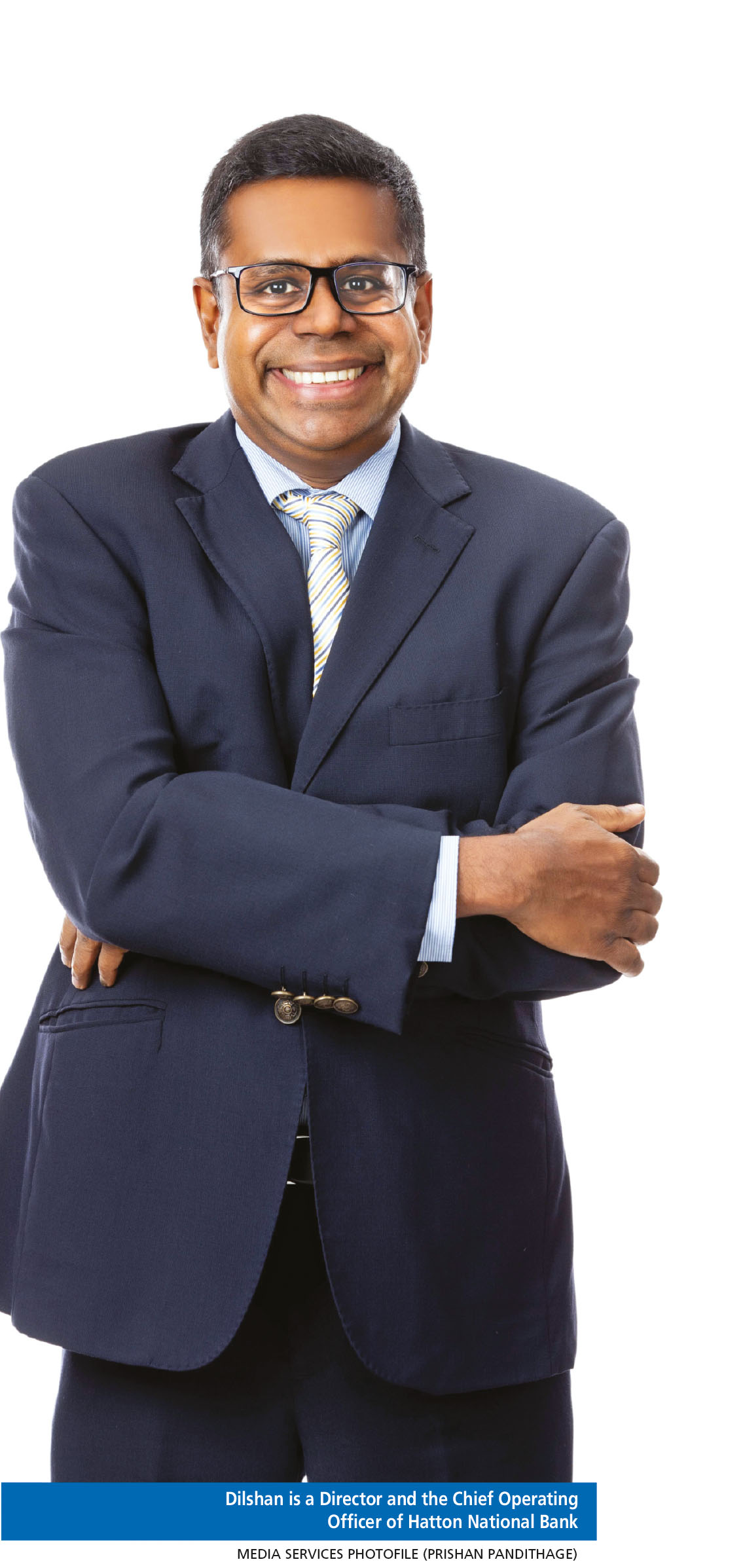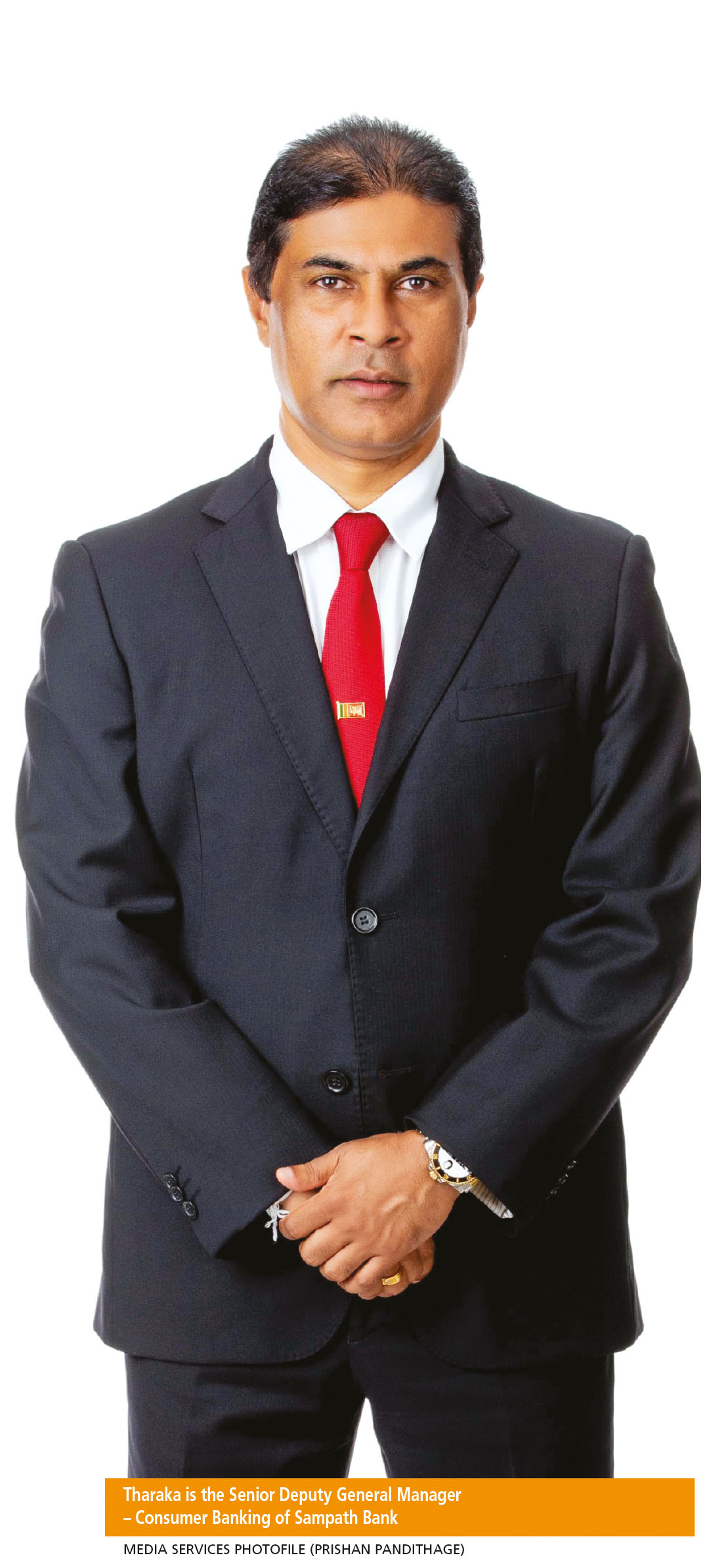BANKING SECTOR
SHORT TAKES
Compiled by Savithri Rodrigo
Dilshan Rodrigo
Tharaka Ranwala
Q: What is the main lesson the banking sector has learned in the past few months?
Dilshan Rodrigo (DR): Never underestimate the importance of brand equity and confidence built over the years, being fast and nimble in uncertain times, and aggressively supporting business revival through supportive supply chain linkages, 24/7 teams and digital channels complementing branch operations.
Tharaka Ranwala (TR): In the present day, we operate in a VUCA (volatility, uncertainty, complexity and ambiguity) environment. Rapid and unpredictable change has become the norm. Therefore, agility and proper understanding of a situation is more important than months of planning.
Q: How do you see the banking sector coping with the new digitalised trend?
DR COVID-19 led to paradigm shifts in how businesses including banks operate. Banks that invested in digital banking infrastructure and made the necessary changes to their business models will gain market share.
TR The sector has already embraced this trend – and is fast embedding technology into banking services. However, when face-to-face interactions with customers reduce, banks face the challenge of cross-selling banking products.
Q: Is the sector ready for this change? And what more needs to be done?
DR Bank transformation is not easy and involves three key steps – i.e. revisiting the business model (introducing outsourcing, centralising, and automating identified business areas and so on), investing in digital infrastructure and having a digitally literate relationship oriented team.
TR Sector readiness can be measured through new users or usage of digital banking activities. But with fast evolving technology, adaptation will be continuous. While the sector may be ready, banking consumers remain sceptical about the use of technology.
Q: What pressures do you foresee in the medium term?
DR The sector will play a pivotal role in managing macroeconomic pressures and supporting business revival. Banking sector consolidation, digital transformation, managing liquidity and asset quality are the other concerns.
TR Reskilling and employee redeployment into new work activities post-COVID, staff redundancies and continuous change in technological developments that challenge operational models.
Q: And what strengths does the sector possess currently to move forward?
DR Resilience, stability and adaptability. Economic and business revival is key to banks’ sustainability, and their success in managing COVID-19 augurs well for a ‘V-shaped’ recovery.
TR The main strength is having qualified and experienced senior leaders working together to face the present challenges. The high banking penetration of over 80 percent also helps.
Q: What global paradigms in the macro landscape are to be expected?
DR Economies would want to strengthen manufacturing and export capabilities. There will be a return to the discipline of balancing budgets, income inequality would worsen and global poverty will increase.
TR This includes the shifting of economic power from the West to the East, resistance to that shift spurring trade wars, and global monetary and fiscal expansion in response to present economic downturns.
Q: What do you make of calls for environmental and social risk management, and sustainable financing practices?
DR Banks have realised that there’s a positive correlation – i.e. being concerned about the environment has a direct link to profitability. CSR must be viewed as a business driver for sustainable performance and not as a compliance requirement.
TR Resource depletion, natural and man-made disasters, pandemics and present economic issues arise from the global population living beyond its means. The youth have identified this, calling for environmental, social and corporate governance (ESG) standards, which is a positive trend.
Q: Does the banking sector suffer from concentration risk with a chunk of assets being in the hands of a few players?
TR No, the present level of spread is healthy. However, it would be astute for smaller players to add more dimensions to the sector by becoming market challengers.
DR Eighty percent of banking assets are with six banks in a sector comprising over 120 players in the financial services industry. There is room for consolidation for sure.
Q: So is the sector likely to consolidate and reshape itself going forward?
DR With margins shrinking, and major pressures on asset quality, profitability and capital adequacy post-COVID, the drive towards consolidation will escalate. Developing an enabling legal infrastructure would accelerate these efforts. Addressing stakeholder pressures including trade unions will be imperative.
TR This is very likely given that many minor players in the market result in a waste of resources for a small market such as Sri Lanka. Consolidation would help Sri Lankan banks reduce their cost structures, thereby passing the benefit onto customers and supporting regional expansion as well.
Q: In your assessment, is there sufficient financial inclusion in the banking sector?
DR With 20 banks, 60 leasing and finance companies, 20,000 unregistered financial institutions and a large informal economy, banks can do more to improve financial inclusion. This includes lending to promising sectors, promoting a female workforce, and creating supply chain linkages between large companies and microfinance segments.
TR Given the economic activity and spread of banking in Sri Lanka, there is sufficient financial inclusion of around 80 percent, according to the World Bank. However, pockets of underbanked segments continue to exist and the sector should take measures to bring them into the formal sector.
Q: What avenues are available for banks to innovate and expand?
DR Many banks that did not innovate have become extinct. Competition stems from fintech, telcos, and internet and social media companies entering the banking space. Embracing change from within and digital transformation are key to survival and growth.
TR Technology offers the best opportunities to innovate and expand. The volatility and uncertainty in these circumstances and milieu represent
an ever expanding opportunity, provided one is quick to observe and take advantage of it.
Q: So what do you see on the horizon for the banking sector in the longer term?
DR The emerging paradigms will be fewer larger digital banks; financial advisory integrated with social media and web conferencing; no bricks and mortar buildings, form filling or queues and less visits to the bank. Banking will be at your pace and time, and fully integrated to echo digital lifestyles.
TR Many growth and expansion opportunities, due to COVID-19 and the prevailing economic downturn. The world will be different and so would the sector; but there will also be many developments outside the sector that may be substitutes for banks, and for which banking entities should be ready and geared.








Leave a comment